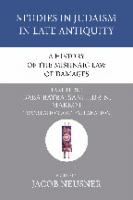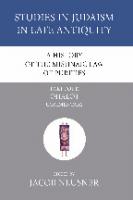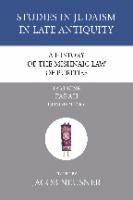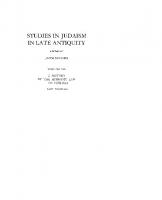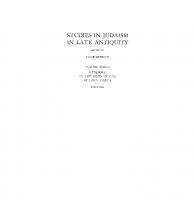A History of the Mishnaic Law of Damages, Part 1: Baba Qamma (Studies in Judaism in Late Antiquity) 1556353650, 9781556353659
The history of Jews from the period of the Second Temple to the rise of Islam. From 'A History of the Mishnaic Law
129 68 14MB
English Pages 200 [201] Year 2007
Cover
Title Page
Copyright
Dedication
Recommend Papers

- Author / Uploaded
- Jacob Neusner (editor)
File loading please wait...
Citation preview
A HISTORY OF THE MISHNAIC LA\V OF DAMAGES PART ONE
STUDIES IN JUDAISM IN LATE ANTIQUITY EDITED BY
JACOB NEUSNER VOLUME THIRTY-FIVE
A HISTORY OF THE MISHNAIC LAW OF DAMAGES PART ONE
A HISTORY OF THE MISHNAIC LAW OF DAMAGES BY
JACOB NEUSNER University Professor The Ungerleider Distinguished Scholar of Judaic Studies Brown University
PART ONE
BABA QAMMA TRANSLATION AND EXPLANATION
Wipf_ & Stock PUBLISHERS Eugene,Oregon
Wipf and Stock Publishers 199 W 8th Ave, Suite 3 Eugene, OR 97401 A History of the Mishnaic Law of Damages, Part 1 Baba Qamma By Neusner, Jacob Copyright©1983 by Neusner, Jacob ISBN 13: 978-1-55635-365-9 ISBN 10: 1-55635-365-0 Publication date 3/20/2007 Previously published by E. J. Brill, 1983
For
lV'illiamand foan Green
TABLE OF CONTENTS Preface .......... . Abbreviations and Bibliography Transliterations Introduction . . . . . . I. Baba Qamma Chapter II. Baba Qamma Chapter III. Baba Qamma Chapter IV. Baba Qamma Chapter V. Baba Qamma Chapter VI. Baba Qamma Chapter VII. Baba Qamma Chapter VIII. Baba Qamma Chapter IX. Baba Qamma Chapter X. Baba Qamma Chapter
. . One Two Three Four Five Six . Seven Eight Nine Ten
IX XVII XXXIV
1
14 21 .
32 52
. . .
67
78 89 111
.
Index to Biblical and Talmudic References . General Index . . . . . . . . . . . . . .
127 142 158 163
PREFACE This book is the first of a four part presentation of Mishnah's division of Damages, to be followed by a study of the history and structure of the law. The work will be complete in five parts, as follows:
I. Baba ,Qamma. Translation and h:x:planation. II. Baba Mesia. Translation and Explanation
III. Baba Batra, Sanhedrin, Makkot. Translation and Explanation. IV. Shebuot, Edtf.yot, Abodah Zarah, Abot, Horqyot. Translation and Explanation.
V. The Mishnaic S)stem of Damages. The purpose and plan of the work follow those of A Risto()' of the Mishnaic Laiv of H7omen, and A HistO()' oJthe Mishnaic Latv of Appointed Times. There are no changes in the established procedures or purposes. Surely the most familiar and the most accessible of all of Mishnah's tractates, Baba Qamma deserves its good name. It presents fairly simple ideas in a clear way. The tractate supplies a still larger proportion of exegesis, effected through both formal means and straightforward declarations of meaning or of generalization, than do most of the other tractates. Its Tosefta is of formidable proportions as well, serving to enrich the meaning of the Mishnah's laws through introducing secondary considerations, on the one side, and supplying its own propositions, complete with their secondary and tertiary expansions and augmentations, on the other. My commentary serves a single, clearly limited and carefully defined, purpose, taking its place in a sequence of other, equivalent commentaries to the several tractates of Mishnah. The character of this translation and explanation in detail expresses the purpose of the larger work of which it is part: to present a history of the Mishnaic law. I have to give an account of the document itself, first of all to state what I believe Mishnah says, in a rendition, in English, as close to the formal and syntactical character of the Hebrew as English permits. This I do in the translation, which itself is a commentary in its wordchoices and patterns and its version of the division of sentences into stichs, of paragraphs into sentences, and of chapters into paragraphs.
X
PREFACE
(But this last depends, for the convenience of the reader, on the printed text of I:Janokh Al beck.) The translation makes no important contribution to the explanation of realia or the identification of various places, persons, and things, mentioned in the document. What it does contribute is the first translation of a rabbinic document to take full and faithful account of the rigidly formalized, public and anonymous character of Mishnaic language. I provide complete form-analytical translation ofMishnah and ofTosefta. The explanation is rather different from any of its predecessors, so different that it must be called "explanation." For if what have been done in the past are called commentaries, ·this cannot be represented as a commentary at all. What I do not say invariably is more important than what I choose to discuss. By radically revising and abbreviating the established exegetical agendum, I believe I have made my richest contribution to the interpretation of Mishnah. This is in two aspects. First, I have tried to force Mishnah to serve as its own commentary. I do so by relying heavily upon those formal and even substantive traits of the document which serve to provide a clear account of Mishnah's meaning and message. I pay careful attention to matters of form and formulation. We shall see time and again that principally through setting up a contrast, placing of a phrase for emphasis, or other obvious linguistic and syntactical modes of highlighting its meaning, Mishnah serves as its own first, and therefore best, commentary. Second, I have revised what I believe to be.the definition of those issues appropriate to, and even acceptable for, exegesis of Mishnah in particular, as a singular document of its period. This last point requires some amplification. There are two sides to the problem of explaining what Mishnah means. Both of them are generated by one absolutely false conception, or, more accurately, misleading analogy. The first problem is the bringing to Mishnah of issues clearly extraneous to its original meaning. This set of comments plainly is needless because the issues are generated by later problems and questions. They are quite naturally addressed to Mishnah, however, by people who assume Mishnah speaks to them and therefore must address issues of importance to them. This ahistorical approach is possibly valid for the generating and unfolding of law. But it is not correct for the interpretation of what Mishnah as a concrete document meant to the particular people who made it up.
PREFACE
XI
The second problem is corollary, namely, the placing of Mishnah's materials into the context of a whole legal system. When Mishnah is read in a larger framework than Mishnah, we are prevented from seeing Mishnah's materials as a coherent corpus on their own. This latter approach to Mishnah is absolutely opposite to our purpose. For I propose to state, and, later, historically to account for the unfolding of, the law of Mishnah in particular. If we assume that Mishnah constitutes a single document-and the internally harmonious formal and intellectual traits of Mishnah require that we make that assumption-then we have no choice but to honor the limits of the document when attempting to describe and interpret it. Until now all commentators to Mishnah have taken only a limited interest in the shape and structure of Mishnah itself. It goes without saying, none to begin with has asked a genuinely historical-exegetical question ("What does this mean to the person who originally said it and who did not know what his successors would want to say about it?"). For their problem was a different one. It was dictated by a social and intellectual task quite separate from ours. They addressed themselves not to the exegesis and expression (let alone the worldview) of a given document. Nor could they imagine the notion that the laws in their hands formed discrete units of information. Quite the contrary, they began with the conception of a completely unitary legal system, expressed in discrete documents originating in diverse places and time, but nonetheless all together forming a timeless, seamless conceptual structure. Their task was defined by this rather platonic metaphor, namely, to relate each of the parts to the transcendent whole, and to force the whole to encompass all of the parts. It is not, as I originally thought, the ahistorical (or, anti-historical) and harmonistic purpose of the earlier exegetes which made their Mishnah-commentaries so intellectually prolix, indeed, indifferent and irrelevant to the text under discussion. That is a misunderstanding which it has taken me many years to recognize. It is, rather, that the earlier exegetes presuppose something much more profound, much less susceptible to articulation. This is the construct, ''Jewish law," or "the halakhah." Of this construct Mishnah constitutes an important component. In their mind the correct approach to Mishnah's interpretation is to relate its ha!akhah to other halakhah, that is, to "the law." This harmonistic, atomistic and yet encompassing, approach is natural for people who keep the law and who take for granted their audience wants to know
XII
PREFACE
the law, even though everyone knows that not all of the law of a given document is practical and practiced. But the point of interest is clear, and it explains to them what is relevant and what is not. Since social context and intellectual framework define what is relevant, their essays-to us, total chaos-to them are orderly and reliable. But the fact remains that in a different world, their language of exegesis is gibberish, just as is ours to them. When we realize this fact, we understand why it is that the distinctive, documentary character of Mishnah itself has attracted so little interest. The reason is that Mishnah as such failed to define the boundaries of an appropriate exegesis. For the halakhist, the definitive canon awaiting explanation and extension is other. That is to say, Mishnah is part of that other canon, the ha!akhah.The canon awaiting interpretation is shaped by Mishnah, only in so far as Mishnah presents its share of legal statements-the law. Consequently by earlier exegetes Mishnah is read not from whole to part, as a sequence of divisions, tractates, and chapters. This I am the first to do, as the formal character of my work makes clear. And this is the right way -and the only right way-to approach the document. But by others Mishnah has been, and is read essentially as a mass of individual sentences, tens of thousands of bits of legal information, all of them part of, and arrayed against, a larger construct, the law; each of them to be placed into juxtaposition with other bits and pieces of the law. So, as I said, the notion of "the halakhah" obliterates the character of Mishnah as an autonomous document and at best allows Mishnah the status of an authoritative sourceof law. The same treatment, of course, is accorded to Tosefta, the two Talmuds, the diverse legal exegetical compilations, Sifra and Sifre, for example, and to much else. The result is that at each point exegetes tend to tell us "everything about everything," so to speak. It is not because they are confused, even though the results are confusing. For despite the fact that their commentaries appear to be not merely allusive, but irrelevant to the text at hand, and even though they are rich in unprovoked questions, artificial dilemmas, and invented solutions, the reason is that the fundamental theory of the document requires precisely those procedures which are followed. If, to take a current and choice example, Saul Lieberman's Tosefta Ki-Fshutah ("a comprehensive commentary to the Tosefta") treats Tosefta as an excuse for long disquisitions on diverse philological and legal questions, the reason is that that is precisely how Lieberman thinks
PREFACE
Xl:11
the work should be done. And the reason, I believe, is not merely the ahistorical character of the mind-set of the traditionalist, but, as indicated, because of the more profound conviction as to the character of the law and its diverse documentary expressions. The result to date has been an exegetical account of immense philological and legal value. We are able to explain a great deal about the meaning and intention of the sentences of the law, as found (as it happens) in Mishnah and Tosefta (and the rest of rabbinical literature). We can link together diverse conceptions and rules appearing here, there, everywhere; they are formed into a single fabric, even (in the monumental codes of the law) a seamless one. We have what is besought, which is the power to draw upon, and apply to specific circumstances, the whole wisdom and weight of the law. That is to say, the established exegetical program has succeeded in doing precisely what it set out to do. The tasks originally defined by the conception of "the law" have been carried out. The one thing we cannot say on the basis of the available commentaries, both "traditional" and "scientific" (both are wildly inappropriate terms!) is to state clearly what it is that Mishnah (to take our example) wishes to say, in its own setting, within the limits of its own redactional framework, upon the subjects chosen by it, and for purposes defined within the mind of those specific people, its authors, who flourished in one concrete social setting. Reading the document by itself, in its historical context and therefore outside of its atemporal, halakhic context, requires a different approach. That approach is represented, I firmly believe, in the pages of this book. It is given by this "explanation." So the need for these volumes of translation and explanation is dictated not solely by the concluding, systemic description and interpretation. That was my conception for Ho(y Things and Women, and, in retrospect, I think I was too apologetic. Nor is the issue of the work solely the historical-primary, original-meaning of the text in the minds of the people who so phrased their ideas and arranged their sentences as to give us these, and not some other, expressions of their ideas. The decisive and determinative issues are simply, What is the Mishnah? What is its shape and structure? What is the agendum of its law? How is that agendum to be delineated and interpreted as a complete and exhaustive account of what Mishnah wishes to say? These questions are answered in this book and its fellows.
XIV
PREFACE
The answers I give here are to these questions, not to those many others already dealt with, with greater or less measure of success, in the established and received exegetical tradition. People who \vant to know what "the tradition" has to say are not apt to open these books and stay on to study them in any event. Other sorts of readers will find their way to these pages. 1 do not think they will finds the methods and suppositions alien or the results unsatisfying. l began this project \veighed down by humility before the intellectual achievements of others who have studied these same problems. I conclude it with greater understanding, and not less appreciation, of their work. But at the same time I see much more clearly that, so far as they claim to speak about Mishnah, they have not done what they promised. So far as I claim to present and briefly to explain what it is that lVIishnah, in its limits, for its purposes, to its chosen audience, wishes to say, 1 do what I claim to do. That fact accounts for the traits of the translation and the character of the explanation---its brevity, severe limitation of the exegetical agendum, and above all, its insistence upon ivlishnah's form and formulary expression as definitive of Mishnah's meaning. This is not meant to excuse or apologi;;,;e.I have worked on Mishnah since 1972, and the last of these books is apt to appear not much before 1984. Twelve years are a long time_to devote to a single document, however complex, when one's interest is in only a limited aspect of said document. For, when all is said and done, my real interest remains focused upon the history and structure of nascent rabbinic Judaism. That means the main work is yet before me, not behind. These twelve years and forty-three books of mine, not to mention many more years of work and many more books of my several doctoral students, all are meant only to prepare the way for a different sort of analysis entirely. This is an approach to Mishnah which is at once more historical, more religious-philosophical, and more religious-historical than has even been attempted. I do not know whether it will succeed. It remains to thank a few among the many to whom much is owed. First of all, I owe thanks to the John Simon Guggenheim Memorial Foundation for awarding to me yet a second Guggenheim Fellowship for 1979-1980 to facilitate the completion of myHJ,io1y of the Mishnaic [,aw of Appointed Times and History of the "Mishnaic T~mvof Damages. This recognition of the interest of the scholarly ,.vorld in the results of my work is much appreciated. It also is important to me. At the same time I owe thanks to Brown University for an extraordinary research leave, awarded in the same connection.
PREFACF
xv
Second, I wish to thank Brown university for paying the costs of typing these manuscripts. Provost Maurice Glicksman and Associate Dean Frank Durand without complaint received a shower of typists' bills. In an age of exceedingly painful budgetary choices, they loyally and generously paid my typists and did so promptly and courteously. This everyday and humble expression of their belief in the worth of my project is just as precious to me as those research fellowships and honorary doctorates which have come my way. Third, I should he remiss if I did not mention hy name the junior colleagues who in my graduate seminar read their work and heard about mine, the graduate students of the period in which this part of the project was coming to completion: Leonard Gordon, Peter Haas, Martin Jaffee, and Alan Peck; and my former colleague, Richard Samuel Sarason, now at Hebrew Union Collega-Jewish Institute of Religion, Cincinnati. Since the work of all of these as well as of some of my former students is an integral part of this project, they in due course will make their own contributions as well. Fourth, my colleagues in the Department of Religious Studies have provided a constructive and helpful framework for my teaching and scholarship. I must single out Professors Wendell S. Dietrich and Ernest S. Frerichs with thanks not only for exemplary collegiality but for friendship and love. Finally, after all these years, I have to mention and take note of the enthusiastic support of my children, Samuel Aaron, Eli Ephraim, Noam Mordecai !\lenahem, and Margalit Leah Berakhah, who were infants when the work began, and who approach maturity as it ends. I never hoped they would read these books, but T should want them to be proud of knowing that, when I was doing the work, they charmed and cheered my life. I could not have done this work without them---nor should I have wanted to. Let a veil of silence be drawn before the next, the best, for only silence can contain all that is felt, all that words cannot say, in homage to Suzanne Richter Neusner. So far as Mishnah presents a code of civil law and serves as a legal code, it is contained in the present and two following tractates, the three great gates to the law, first, middle, and last. It is appropriate to offer these hooks in the honor of three lawyers who have meant a great deal to my family and me. The first is for William Green, tbe best lawyer in New Hampshire, and to his wife, Joan, in thanks for all their love has done for us. J. N. Providence, Rhode Island
ABBREVIATIONS AND BIBLIOGRAPHY Abrahams AE Ah. Albeck
= Israel Abrahams, "Sanhedrin," in J. Hastings,
Encyclopaedia of Religion and Ethics, XI, 184-185. Tosafot R. 'Aqiba Egger. From Mishnah, ed. Romm.
>Ahilot I;Ianokh Albeck, Shishah sidre Mishnah. Seder Neziqin (Tel Aviv, 1952). S. Albeck, "Acquisition," Enryclopedia judaica 2: 216-221. Albeck, Acquisition Albeck, Avot S. Al beck, "A vot Nezikin," Enryclopedia Judaica 3: 986989. Albeck, Damages S. Albeck, "Damages," Enryclopedia Judaica 5: 1233-1236. S. Albeck, "Assignment (of debt)," Enryclopedia fudaica Albeck, Debt 3:768-770. Albeck, Din Shalom Albeck, Dine ha-mamonot ha-Talmud (Tel Aviv, 1976). Albeck, Gerama S. Albeck, "Gerama and Garme," Encyclopedia Judaica 7:430-431 Albeck, Gift S. Al beck, "Gift," Encyclopedia Judaica 7: 560-563. Albeck, Lost S. Albeck, "Lost Property," Encyclopedia Judaica 11 :504506. Albeck, Maritime S. Al beck, "Maritime Law," Encyclopedia Judaica 11: 996997. Albeck, Ownership S. Albeck, "Ownership," Enryclopedia judaica 12: 15311534. Albeck, Property S. Albeck, "Property," Encyclopediajudaica 13:1146-1149. Albeck, Sale S. Albeck, "Sale," Encyclopedia]udaica 14:675-680. Albeck, Sanhedrin Chanoch Albeck, "ha-Sanhedrin u-Nesi'ah," Zion 1942-43, 8: 165-178. Albeck, Torts S. Albeck, "Torts," Encyclopedia judaica 15: 1272-1277. Albeck, Yeush S. Albeck, "Ye'ush," Encyclopedia Judaica 16:774-775. Amram D. W. Amram, "Retaliation and Compensation," Jewish Quarterly Review 1911, NS 2:191-211. Aptowitzer = Victor Aptowitzer, Die vrischen Rechtsbucher und das mosiiisch-talmudische Recht (Wien, 1909). Aptowitzer, Law Victor Aptowitzer, "Observations on the Criminal Law of the Jews," ]QR 1924-25, 15:77ff. Ar. 'Arakhin Auerbach, C. C. Auerbach, "The Talmud-a gateway to the common law," Westirn Reserve Lan, Review 1951 (June), 3: 5-49. Auerbach, L. L. Auerbach, Das judische Obligationrecht nach den Quellen und mit besondererBerucksichtigung des romischen und deutschen Rechts vstematisch dargestellt (Berlin, 1871).
A.Z.
B. B.B. B.M. B.Q.
'Abodah Zarah Babylonian Talmud = Baba> Batra, Baba' Me~i'a' = Baba' Qamma'
Mrs. Lee Haas served as bibliographical research assistant for this project.
XVIII
ABBREVIATIONS
Babany Bacher Baruk Baumgarten Bayne Beaucamp Ber. Berger Berkovits Berlin, 1968 Berlin, 1972 Berlin, 1971 Bert. Bes. Bickermann Bik. Blackman Blau,
J.
Blau, L. Blau, Papyrus Blau, Prosbol
Blidstein Blidstein, Capital Blinzer Blum Bossowski
=
AND BIBLIOGRAPHY
Leon Babany, Institutions Juridiques des Romains, comparles aux Institutions Juridiques des Hebreux (Paris, 1926). W. Bacher, "Sanhedrin," in J. Hastings, A Dictionary of the Bible, IV: 397-402. H. Baruk, "Le tsedek dans le droit hebratque; !'organisation de la justice et l'examen des temoignages," Hatikvah 1969, 7:9-35. J. M. Baumgarten, "The duodecimal courts of Qumran, Revelation, and the Sanhedrin," Journal of Biblical Literature 1976, 95:59-78. D. C. Bayne, "Essay on the Hebrew Civil Code," Cleveland-Marshal Law Review 1954, 3: 23-32. E. Beaucamp, "La justice en Israel," Populus Dei ... ; studi in onorede/ Card. A. Ottaviani (Rome, 1969), 201-235. Berakhot Isaiah Berger, ed., Analytical Index to the Jewish Quarterly Review, 1889-1908 (N.Y., 1956). E. Berkovits, "The biblical meaning of justice," Judaism 1969, 18:188-209. Charles Berlin, Harvard Universiry Library. Catalogue of Hebrew Books (Cambridge, 1968), I-VI. Supplement (Cambridge, 1972), I-III. Widener Library Shelf!ist, 39. Judaica (Cambridge 1971). 'Obadiah of Bertinoro. From Mishnah, ed. Romm. Be~ah E. Bickermann, "'Al ha-Sanhedrin," Zion 1938, 3:356-66. Bikkurim Philip Blackman, Mishnqyoth. Vol. IV. Order Nezikin. Pointed Hebrew Text, Introductions, Translation, Notes, Supplement, Appendix, Indexes (London, 1952). J. Blau, "Lex Talionis," Yearbook of the Central Conference of American Rabbis 1916, 26-336-66. Ludwig Blau, Der Concursus Vitierum nach Talmudischen Recht (Budapest, 1887). Ludwig Blau, "Die Strafklauseln der griechischen Papyrus Urkunden beleuchtet durch die aramaischen Papyri unddurch den Talmud," MGWJ1919, 63: 138-155. Ludwig Blau, "Prosbol im Lichte der Griechischen Papyri und der Rechtsgeschichte," Sonderabdruck aus Festschrift zum 50-jahrigen bestehender Franz-Josef-Landesrabbinerschule (Budapest, 1927), pp. 96-151. G. Blidstein, "Notes on Hejker Bet-Din in Talmudic and Medieval law," Dine Israel 1973, 4: 35-49. G. J. Blidstein, "Capital punishment; the classic Jewish discussion," in Understanding the Talmud, selected by A. Corre (N.Y., 1975), pp. 313-324. J. Blinzer, "Das Synedrium von Jerusalem und die Strafprozessordnung der Mischna," Zeitschrift fur die neutestamentliche Wissenschaft 1961, 52: 54. F. Blum, Le Synhedrin (Strassbourg, 1889). Frank Bossowski, "Roman Law and Hebrew Private Law," Bulletino dell' Instituto di Diritto Romano "Vittoria Scialoje," 1939, XL VI n.s. V: 354-363.
ABBREVIATIONS
Brauner Buchler Bur kill Buss C
Carmichael Cazelles Chajes Cohen Cohen Cohen, Arbitration Cohen, Peculium Cohen, Justification
Cohn Cohn, Admission Cohn, Ancient Cohn, Bet Cohn, Confiscation Cohn, Evidence Cohn, Pleas Cohn, Practice Cohn, Witness Cohn, Talion
AND BIBLIOGRAPHY
XIX
R. A. Brauner, "Some Aspects of offense and penalty in the Bible and the literature of the ancient Near East," Gratz College Annual of Jewish Studies 1974; 3:9-18. Adolf Buchler, Das Synedrion in Jerusalem und das grosse Beth-Din in der Quaderkammer des jerusalemischen Tempels (Wien, 1902). T. A. Burkill, "Competence of the Sanhedrin," Vigiliae Christianae 1956, 10: 80-96. Martin Buss, "The distinction between civil and criminal law in ancient Israel," Proceedings of the Sixth World Congress of Jewish Studies 1977, 6, 1 :51-62. W. H. Loewe, The Mishnah of the Palestinian Talmud (Hammishnah 'al pi ketab-:)lad Cambridge) (Jerusalem, 1967). C. M. Carmichael, "A singular method of codification of law in the Mishpatim," Zeit.rchrift ju, lie Alttestamentliche Wissenschoft 1972, 84: 19-25. H. Cazelles, "La transgression de la loi en tant que crime et delit," Populus Dei . .. , studi in onore de! Card. A. Ottaviani (Rome, 1969), 521-528. H. P. Chajes, "Les Juges juifs en Palestine, de l'an 70 a l'an 500," Revue des etudesjuives 1899, 39:39-52. B. Cohen, "An essay on possession in Jewish law," in Understanding the Talmud, selected by A. Corre (N.Y., 1975), pp. 325-329. Boaz Cohen, "The relationship of Jewish to Roman Law," Jewish Quarterfy Review, 1944, 34: 267-280. Boaz Cohen, "Arbitration in Jewish and Roman Law," Revue Internationale des Droits de l'Antiquite 1958, 5:165223. Boaz Cohen, "Peculium in Jewish and Roman Law," American Academy for Jewish Research. Proceedings, 1951, 20: 135-234. M.A. Cohen, "Justification and excuse in the Judaic and common law: the exculpation of a defendant charged with homicide," New York Universi!J Law Review 1977, 52: 599-628, 970-3. H. H. Cohn, "The penology of the Talmud," Israel Law Review 1970, 5:53-74. H. H. Cohn, "Admission," EncyclopediaJudaica ~:290-292. H. H. Cohn, "Ancient Jewish equity," in Equi!) in the World's Legal ~'ystems ... dedicated to R. Cassin (Brussels, 1973). H. H. Cohn, "Bet Din and judges," Encyclopedia Judaica 4:719-727. H. H. Cohn, "Confiscation, expropriation, forfeiture," EncyclopediaJudaica 5: 880-882. H. H. Cohn, "Evidence," EncyclopediaJudaica 6:991-997. H. H. Cohn, "Pleas," Encyclopedia Judaica 13: 631-636. H. H. Cohn, "Practice and procedure," Encyclopedia judaica, 13: 952-962. H. H. Cohn, "Witness," EncyclopediaJudaica 16: 584-590. H. H. Cohn, "Talion," Enfyciopaedia Judaica (Jerusalem, 1971), 15:742
xx Cohn, Usury Conflict
ABBREVIATIONS
AND BIBLIOGRAPHY
H. H. Cohn, "Usury," Enryclopedia Judaica 16:27-33. "Conflict resolution and the legal culture: a study of the rabbinical court," Osgoode Hall Law Journal 1971, 9:335. "Criticism of the state in ancient Jewish tradition," Criticism Ohio State Law Journal 1970, 31 :322. Herbert Danby, "The Bearing of the Rabbinical Criminal Danby Code on the Jewish Trial Narratives in the Gospels," The Journal of Theological Studies 1919-20, 21: 51-76. D. Daube, "Negligence in the Early Talmudic Law of Daube Contract (Peshi'ah)," Festschrift Fritz Schulz (Weimar, 1951). Daube, Civil David Daube, The Civil Law of the Mishnah (New Orleans, 1944). (Also in Tulane Law Review 1943-4, 18:351-407.) Daube, Codes David Daube, "Codes and codas in the Pentateuch," Juridical Review 1941, 53:242-261. Daube, Collaboration = David Daube, Collaboration with tyranny in Rabbinic law (Riddell Memorial Lectures) (London, 1965). Daube, Direct D. Daube, "Direct and Indirect Causation in Biblical Law," Vetus Testamentum 1961, 11 :266ff. D. Daube, "The law of witnesses in transferred operation Daube, Law (in rabbinic thought)," in Gaster Festschrift. Journal of the Ancient Near Eastern Society, pp. 91-93. Daube, Romans D. Daube, "Derelicto, occupatio, and traditio: Romans and rabbis," Law Quarter/y Review 1961; 77: 382. Daube, Studies D. Daube, Studies in Biblical Law (Cambridge, 1947). Daube, Suicide David Daube, "Josephus on suicide and liability of depositee," Juridical Review 1964, 1964: 212. Dema'i. Dem. L. N. Dembitz, "Is there Roman law in the Talmud?" Dembitz Hebrew Union CollegeJournal 1901, V: 160-61. G. D'Ercole. "The juridical structure of Israel from the D'Ercole time of her origin to the period of Hadrian," Populus Dei . .• , studi in onore de! Card. A. Ottaviani (Rome, 1969), 389-461. Deuteronomy Deut. Ed. 'Eduyot Hiddushi Elryyahu Migreiditz. From Mishnah, ed. Romm BG (Vilna, 1887). Ehrman A. Z. Ehrman, "Antichresis," Encyclopediafudaica 3:59-60. Eisenstadt S. Eisenstadt, En Mishpat (Jerusalem, 1931) pp. 378-382. M. Elon, "Limitation of actions," Encyclopedia Judaica Elon, Actions 11:251-254. M. Elon, "Arbitration," Enryclopedia Judaica 3: 294-300. Elon, Arbitration Elon, Compromise M. Elon, "Compromise," Encyclopedia Judaica 5: 857-859. Elon, Contract M. Elon, "Contract," Encyclopedia Judaica 5: 923-933. M. Elon, "Execution," Encyclopedia Judaica 6: 1007-1020. Elon, Execution Elon, Gevul M. Elon, "Hassagat Gevul," EncyclopediaJudaica 7:14601466. Elon, HaAnakah M. Elon, "Ha'anakah, "EnryclopediaJudaica 7: 1003-1007. Elon, Law M. Elon, "Law of Obligations," Enryclopedia Judaica 12: 1310-1316. Elon, Lien M. Elon, "Lien," Enryclopedia Judaica 11 :227-232. Elon, Pledge M. Elon, "Pledge," EncyclopediaJudaica 13: 636-644.
ABBREVIATIONS
Elon, Suretyship Elon and Levitats Elon and Levitats, Hekdesh Englard Enker Epstein Epstein, Nusa!J Epstein, Tan. Erub. Eschelbacher Falk Falk, Einfluss Falk, Elements Falk, Hand. Falk, Introduction Falk, Law Fassel Faur Fees Fensham Fensham, Widow Finkelstein
Finkelstein, Eye Finkelstein, Sanhedrin
AND BIBLIOGRAPHY
XXI
M. Elon, "Suretyship," Encyclopedia Judaica 15:524-529. M. Elon and I. Levitats, "Hazakah," Encyclopedia Judaica 7: 1516-1523. M. Elon and I. Levitats, "Hekdesh," Encyclopedia .f udaica 8:279-287. I. Englard, "The law of torts in Israel; the problems of common law codification in a mixed legal system," American Journal of Comparative Law 1974, 22:302-329. A. Enker, "Self-incrimination in Jewish law," Dine Israel 1923, 4:107-124. Isidore Epstein, Social Legislation in the Talmud (London, 1943). Y. N. H. Epstein, Mabo lenusa!Jhammishnah (Tel Aviv, 1954). Y. N. H. Epstein, Mebo'ot lesifrut hattana'im. Mishnah tosifta, ummidrashe halakhah. Ed. E. S, Melammed (Tel Aviv, 1957). it IV (Jerusalem, 1962), cols. 84-46. Babylonian Talmud Codex Munich (95) (Repr. Jerusalem, 1971). Mishnah Ma'aserot. G. MacCormack, "Revenge and Compensation in Early Law," American Journal of Comparative Law 1973, 21: 81ff. G. C. Macholz, "Zur Geschichte der Justizorganisation in Juda," Zeitschrijt fur alttestamentliche Wissenschaft 1972, 84:314-340. G. C. Macholz, "Die Stellung des Konigs in der israelitischen Gerichtsverfassung," Zcitschrift fur alttestamentliche Wissenschaft 1972, 84: 157-182. The Code of Maimonides. Book Six. The Book of Asseverations. Translated from the Hebrew by B. D. Klien (New Haven & London, 1962: Yale University Press). The Code of Maimonides. Book Thirteen. The Book of Civil Laws. Translated from the Hebrew by Jacob J. Rabinowitz (New Haven and London, 1949: Yale University Press). Moses b. Maimon, Mishnah. Seder Neziqin. Trans. by Yosef Kappa}:i (Second printing, Jerusalem, 1969). The Code of Maimonides. Book Fourteen. The Book of Judges. Translated from the Hebrew by Abraham M. Hershman (New Haven, 1949: Yale University Press). The Code of Maimonides. Book Eleven. The Book of Torts. Translated from the Hebrew by Hyman Klein (New Haven and London, 1954: Yale University Press). Henry Maine, Ancient Law (London, 1910). Makkot Makhshirin R. P. Maloney, "Usury in Greek, Roman and rabbinic thought," Traditio 1971, 27:79-109. Hugo Mantel, Studies in the Hist01y of the Sanhedrin (Cambridge, Mass., 1961). R. Margolith, "The Requisites for Appointment to the Sanhedrin," (Hebrew) Sinai 1946-7, 10:16ff. A. Marmorstein, "Ab Bet Din," Enryclopaedia Judaica I, pp. 104-109. M. May, "Jewish criminal law and legal procedure," Journal of Criminal Law and Crimonology 1940, 31 :438-47. S. Mayer, Die Rechte der lsraeliten, Athener und Riimer mit Rucksicht auf die neuen Gesetzungen,ftirjuristen, Staatsmiinner, Theologen,Philologen, und Geschichtsforscher in Parallelen dargestel!t ... Vol. I. Das offentliche Recht (Leipzig, 1862). Vol. II. Das privat Recht (Leipzig, 1866). Vol. III. Geschichte der Strafrechtes Verg!eichende Darstellung der Strafrechtlichen Gesetze und Bestimmungen a/fer Kulturvolker von Moses Solon . .. bis zur Gegenwart (Trier, 1876).
ABBREVIATIONS
BJULIOGR,\
Pl IY
XXV[l
J.
McKay
J\{e.
Meg. 1\iclammed, Midrash
Melammed,
AND
Ta!ml!d
Men. Mendelsohn :\lend en ball "Ylcndenhall, Laiv Menes
MGWJ
Mikliszanski Miq. Mishcon and Cobcn -
W. McKay, "Ex. 23: 1-3, 6-8; a decaloguc for the administration of justice in the city gate," Vettu Testamentum 1971, 21 :311-325. Me'ilah Megillah E. $. Melammcd, Flayyapas sheben midrashe ha!akhah !aml/!ish11ahvelattosefta (Jerusalem, 1967). E. S. Melammed, Pirql maho batta!mud (Jerusalem, 1973) . .,\knal;ot S .. Mendelsohn, The CriJJJi1wlJ11risprudence of the Ancimt HehreiPs (Baltimore, 1891). G. E. 1v[cndenhall, "Covenant forms in Israelite tradition," Bih!ical Archaeologist 1954, 17: 50-76. G. E. Mendenhall, "Ancient oriental and Biblical Law," Biblical Archaeologist 1954, 17: 26-46. Abram J\knes, "Die vorexilischen Gcsctzc Israels im Zusammenhang seiner Kulturgeschichtlichen Entwicklung," Zeitschrift fiir die alttestament!iche lf7issenschaften, Beibefte, 1928, 50:1-143. J'vfonatschrift fur die Geschichtt mid lf7issenschaft desjudenth1 1111s. J. K. Mikliszanski, "The La\\· of Retaliation and the Pcntateuch,"Journal oflJihlicrll Litcralure 1947, 66: 295-303.
Miqva'ot '.• 1hodah Zarah. Translated il!to Hng!is/Jwith Notts, G!ossarv, and Indices. By A. '\Llshcon and A. Cohen (London, 1948:
Soncino Press). ii.IL
Mishneh Lamme!ekb. Commentary to Maimonides, 1l1ishneh Torah. Judah Rosannes 1657-1727. For source, sec KM.
Morell
S. Morell, "The Constitutional limits of communal government in Rabbinic law," .fewish .\'ocia! Studies 1971, 33:87-119. _\Jo'ed Qatan J\!ele'khet Shelomo. Shelomo bar JoshLia Adeni, 1567-1625. From Mishnah, ed. Romm. Dadd Henrich Muller, Die Hammurabis und ihr
M.Q. MS Muller
Verha!tnis zur mosaische11 Ce.dzge!J11ng smvie zu den ,Yil Tafdn (Wien, 1903). Mishnah 'im j>erttsh 1-laR.amham. Dejw Risho'n Napoli
l\apier
Naz. Ned. Neg. Nid. Norden Noth Num. NS Oettli
[5]252 [1492] (Jerusalem, 1970). B. D. 1"apicr, "Community under law," htterjJretation 1953, 7:404-17. Nazir Nedarim Ncga'im r..;;iddah J. "-.orden, Auge um .Al(!;c Lahn ll!JJ Zahn (Berlin, 1926). .\lartin Noth, Die Geset~:e im Pmldteuch, ihre Voraussel• ;;J/12/!;tn und ihr Sinn (flallc, 1040). Numbers $cvi Gutmacher, Na~alat ,revi. 111QA!H. Samuel Ocali, Das Gesetz Hammurabis 1111d die Thora Israels (Leipzig, 1903).
XXVIII
ABBRE\'IATIONS
Oh. Or. Ostersetzer p Pa Par. Parly Passamaneck
Passamaneck, Rabbis Passamaneck, 7'1vo Patrick Paul Pes, Pfeiffer
Pharisees
Phelps Phillips Phillips, Interpretation Ploeg
-
Preiser
Prenzcl Prevost
Purities
QA Qchati Qll Q"\fH QS Rabad
=
AND BIBLIOGR.\PTIY
'Ohalot 'Orlah G. Ostcrsetzcr, "Parhedrin-Porertin," Zion 1939, 4: 294-306. Shishah sidri mis/mah. Ketab vad Parina Derossi 138 (Rcpr.: Jerusalem, 1970). Afishnah ketab yad Paris. Paris 32S-329 (Repr.: Jerusalem, 1973). Parah Jean de Parly, Code civil et penril du/11daisme (Paris, 1896). S. Passamaneck and J .. Myers, "Aspects of land use and commercial regulation in medieval rabbinic sources," Rcvm Internationale des Droits de!' /lntiquite 1969, 16: 31-71. S. M. Passamancck and L. M. Brown, "The rabbis; preventive law lawyers," Israel Lmv Revie,v 1973, 8: 538549. S. M. Passamaneck, "Two Aspects of rabbinical maritime law," Journal of Je1vish St11dies 1971, 22:53-67. D. Patrick, "Casuistic law governing primary rights and duties," _fournal of Biblical Literaf11re 1973, 92: 180-184. S. \f. Paul, Studies in the Book of the Covenant in the Light of C1me!form and Biblical La1/J (Leiden, 1970). Pcsal;iim Aclalhert Pfeiffer, Die Stellung der i.rraefitischenGesetzgebung ?:JI den 1PichtigstenProblemen des sozialen l,ehens (Freiberg, 1905). J. Neusner, The Rabbinic Traditions about the Pharisees before 70 (Leiden, 1971) I-lII. L. Phelps, "::V[oscsand his la,cv-s,"Kentucky State Bar/oumal 1944 (June), 8:19-24. Anthony Phillips, Ancient Israel's Criininal Law. A 1Ve1v Approach to the Decalogue (Oxford, 1970). A. Phillips, "Interpretation of 2 Samuel XII: 5-6," !/et11sTe.rtainentuin 1966, 16: 242-4. J. P. \1. van der Ploeg, "Les judges en Tsrael," Populus Dei .. ., st11diin onore def Card. A. Ottaviani (Rome, 1969). \V. Preiser, "Zur rechtlichen J'\:arur

